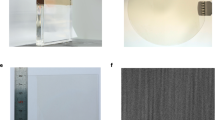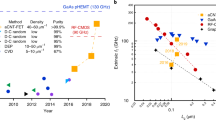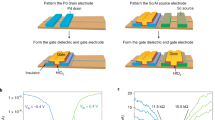Abstract
Electronic devices based on carbon nanotubes are among the candidates to eventually replace silicon-based devices for logic applications. Before then, however, nanotube-based radiofrequency transistors could become competitive for high-performance analogue components such as low-noise amplifiers and power amplifiers in wireless systems. Single-walled nanotubes are well suited for use in radiofrequency transistors because they demonstrate near-ballistic electron transport and are expected to have high cut-off frequencies. To achieve the best possible performance it is necessary to use dense arrays of semiconducting nanotubes with good alignment between the nanotubes, but techniques that can economically manufacture such arrays are needed to realize this potential. Here we review progress towards nanotube electronics for radiofrequency applications in terms of device physics, circuit design and the manufacturing challenges.
This is a preview of subscription content, access via your institution
Access options
Subscribe to this journal
Receive 12 print issues and online access
$259.00 per year
only $21.58 per issue
Buy this article
- Purchase on Springer Link
- Instant access to full article PDF
Prices may be subject to local taxes which are calculated during checkout







Similar content being viewed by others
References
Dresselhaus, M. S., Dresselhaus, G. & Eklund, P. C. Science of Fullerenes and Carbon Nanotubes. (Academic Press, 1996).
Saito, R., Dresselhaus, G. & Dresselhaus, M. S. Physical Properties of Carbon Nanotubes. (Imperial College Press, 1998).
Zhou, X. J., Park, J. Y., Huang, S. M., Liu, J. & McEuen, P. L. Band structure, phonon scattering, and the performance limit of single-walled carbon nanotube transistors. Phys. Rev. Lett. 95, 146805 (2005).
Durkop, T., Getty, S. A., Cobas, E. & Fuhrer, M. S. Extraordinary mobility in semiconducting carbon nanotubes. Nano Lett. 4, 35–39 (2004).
Cao, Q. & Rogers, J. Ultrathin films of single-walled carbon nanotubes for electronics and sensors: A review of fundamental and applied aspects. Adv. Mater. 21, 29–53 (2009).
Burke, P. J. AC performance of nanoelectronics: Towards a ballistic THz nanotube transistor. Solid State Electron. 40, 1981–1986 (2004).
Guo, J., Hasan, S., Javey, A., Bosman, G. & Lundstrom, M. Assessment of high-frequency performance potential of carbon nanotube transistors. IEEE Trans. Nanotech. 4, 715–721 (2005).
Alam, K. & Lake, R. Performance of 2 nm gate length carbon nanotube field-effect transistors with source/drain underlaps. Appl. Phys. Lett. 87, 073104 (2005).
Hasan, S., Salahuddin, S., Vaidyanathan, M. & Alam, A. A. High-frequency performance projections for ballistic carbon-nanotube transistors. IEEE Trans. Nanotech. 5, 14–22 (2006).
Castro, L. C. et al. Method for predicting fT for carbon nanotube FETs. IEEE Trans. Nanotech. 4, 699–704 (2005).
Yoon, Y., Ouyang, Y. & Guo, J. Effect of phonon scattering on intrinsic delay and cutoff frequency of carbon nanotube FETs. IEEE Trans. Electron Dev. 53, 2467–2470 (2006).
Baumgardner, J. E. et al. Inherent linearity in carbon nanotube field-effect transistors. Appl. Phys. Lett. 91, 052107 (2007).
Ural, A., Li, Y. M. & Dai, H. J. Electric-field-aligned growth of single-walled carbon nanotubes on surfaces. Appl. Phys. Lett. 81, 3464–3466 (2002).
Joselevich, E. & Lieber, C. M. Vectorial growth of metallic and semiconducting single-wall carbon nanotubes. Nano Lett. 2, 1137–1141 (2002).
Huang, S. M., Cai, X. Y. & Liu, J. Growth of millimeter-long and horizontally aligned single-walled carbon nanotubes on flat substrates. J. Am. Chem. Soc. 125, 5636–5637 (2003).
Huang, S., Woodson, M., Smalley, R. & Liu, J. Growth mechanism of oriented long single walled carbon nanotubes using fast-heating chemical vapor deposition process. Nano Lett. 4, 1025–1028 (2004).
Yu, Z., Li, S. & Burke, P. J. Synthesis of aligned arrays of millimeter long, straight single walled carbon nanotubes. Chem. Mater. 16, 3414–3416 (2004).
Huang, L. et al. Cobalt ultrathin film catalyzed ethanol chemical vapor deposition of single-walled carbon nanotubes. J. Phys. Chem. B 110, 11103–11109 (2006).
Ismach, A., Segev, L., Wachtel, E. & Joselevich, E. Atomic-step-templated formation of single wall carbon nanotube patterns. Angew. Chem. Int. Ed. 43, 6140–6143 (2004).
Ago, H. et al. Aligned growth of isolated single-walled carbon nanotubes programmed by atomic arrangement of substrate surface. Chem. Phys. Lett. 408, 433–438 (2005).
Han, S., Liu, X. L. & Zhou, C. W. Template-free directional growth of single-walled carbon nanotubes on a- and r-plane sapphire. J. Am. Chem. Soc. 127, 5294–5295 (2005).
Kocabas, C. et al. Guided growth of large-scale, horizontally aligned arrays of single-walled carbon nanotubes and their use in thin-film transistors. Small 1, 1110–1116 (2005).
Ago, H. et al. Competition and cooperation between lattice-oriented growth and step-templated growth of aligned carbon nanotubes on sapphire. Appl. Phys. Lett. 90, 123112 (2007).
Ding, L., Yuan, D. N. & Liu, J. Growth of high-density parallel arrays of long single-walled carbon nanotubes on quartz substrates. J. Am. Chem. Soc. 130, 5428–5429 (2008).
Zhou, W. W., Rutherglen, C. & Burke, P. Wafer scale synthesis of dense aligned arrays of single-walled carbon nanotubes. Nano Research 1, 158–165 (2008).
Kang, S. J. et al. Printed multilayer superstructures of aligned single-walled carbon nanotubes for electronic, applications. Nano Lett. 7, 3343–3348 (2007).
Zhang, G. et al. Selective etching of metallic carbon nanotubes by gas-phase reaction. Science 314, 974–977 (2006).
Yang, C. M. et al. Preferential etching of metallic single-walled carbon nanotubes with small diameter by fluorine gas. Phys. Rev. B. 73, 075419 (2006).
Ding, L. et al. Selective growth of well-aligned semiconducting single-walled carbon nanotubes. Nano Lett. 9, 800–805 (2009).
Li, Y. et al. Preferential growth of semiconducting single-walled carbon nanotubes by a plasma enhanced CVD method. Nano Lett. 4, 317–321 (2004).
An, L., Fu, Q., Lu, C. & Liu, J. A simple chemical route to selectively eliminate metallic carbon nanotubes in nanotube network devices. J. Am. Chem. Soc. 126, 10520–10521 (2004).
Balasubramanian, K., Sordan, R., Burghard, M. & Kern, K. A selective electrochemical approach to carbon nanotube field-effect transistors. Nano Lett. 4, 827–830 (2004).
Strano, M. S. et al. Electronic structure control of single-walled carbon nanotube functionalization. Science 301, 1519–1522 (2003).
Collins, P. C., Arnold, M. S. & Avouris, P. Engineering carbon nanotubes and nanotube circuits using electrical breakdown. Science 292, 706–709 (2001).
Kang, S. J. et al. High-performance electronics using dense, perfectly aligned arrays of single-walled carbon nanotubes. Nature Nanotech. 2, 230–236 (2007).
Amlani, I. et al. in 8th IEEE Conf. Nanotech 239–242 (IEEE, 2008).
Lin, A. et al. Threshold voltage and on-off ratio tuning for multiple-tube carbon nanotube FETs. IEEE Trans. Nanotech. 8, 4–9 (2009).
Ryu, K. et al. CMOS-analogous wafer-scale nanotube-on-insulator approach for submicrometer devices and integrated circuits using aligned nanotubes. Nano Lett. 9, 189–197 (2009).
Shim, H., Song, J., Kwak, Y., Kim, S. & Han, C. Preferential elimination of metallic single-walled carbon nanotubes using microwave irradiation. Nanotechnology 20, 065707 (2009).
Huang, H., Maruyama, R., Noda, K., Kajiura, H. & Kadono, K. Preferential destruction of metallic single-walled carbon nanotubes by laser irradiation. J. Phys. Chem. B 110, 7316–7320 (2006).
Hersam, M. Progress towards monodisperse single-walled carbon nanotubes. Nature Nanotech. 3, 387–394 (2008).
Li, X. et al. Langmuir-Blodgett assembly of densely aligned single-walled carbon nanotubes from bulk materials. J. Am. Chem. Soc. 129, 4890–4891 (2007).
Rutherglen, C., Jain, D. & Burke, P. RF resistance and inductance of massively parallel single walled carbon nanotubes: Direct, broadband measurements and near perfect 50 ohm impedance matching. Appl. Phys. Lett. 93, 083119 (2008).
Krupke, R., Linden, S., Rapp, M. & Hennrich, F. Thin films of metallic carbon nanotubes prepared by dielectrophoresis. Adv. Mater. 18, 1468–1468 (2006).
Boccaccini, A. R. et al. Electrophoretic deposition of carbon nanotubes. Carbon 44, 3149–3160 (2006).
Morgan, H. & Green, N. G. AC Electrokinetics: Colloids and Nanoparticles (Research Studies Press, 2003).
Krupke, R., Hennrich, F., Lohneysen, H. & Kappes, M. M. Separation of metallic from semiconducting single-walled carbon nanotubes. Science 301, 344–347 (2003).
Krupke, R., Hennrich, F., Kappes, M. & Lohneysen, H. Surface conductance induced dielectrophoresis of semiconducting single-walled carbon nanotubes. Nano Lett. 4, 1395–1400 (2004).
Baik, S., Usrey, M., Rotkina, L. & Strano, M. Using the selective functionalization of metallic single-walled carbon nanotubes to control dielectrophoretic mobility. J. Phys. Chem. B 108, 15560–15564 (2004).
Kim, Y. et al. Dielectrophoresis of surface conductance modulated single-walled carbon nanotubes using catanionic surfactants. J. Phys. Chem. B 110, 1541–1545 (2006).
LeMieux, M. C. et al. Self-sorted, aligned nanotube networks for thin-film transistors. Science 321, 101–104 (2008).
Engel, M. et al. Thin film nanotube transistors based on self-assembled, aligned, semiconducting carbon nanotube arrays. ACS Nano 2, 2445–2452 (2008).
Sharma, R., Lee, C. Y., Choi, J. H., Chen, K. & Strano, M. S. Nanometer positioning, parallel alignment, and placement of single anisotropic nanoparticles using hydrodynamic forces in cylindrical droplets. Nano Lett. 7, 2693–2700 (2007).
Chen, Z., Appenzeller, J., Knoch, J., Lin, Y.-M. & Avouris, P. The role of metal-nanotube contact in the performance of carbon nanotube field-effect transistors. Nano Lett. 5, 1497–1502 (2005).
Kim, W. et al. Electrical contacts to carbon nanotubes down to 1 nm in diameter. Appl. Phys. Lett. 87, 173101 (2005).
Liu, W. Fundamentals of III-V devices: HBTs, MESFETs, and HFETs/HEMTs. (Wiley, 1999).
Gupta, M. S. Power gain in feedback amplifiers, a classic revisited. IEEE Trans. Microw. Theory 40, 864–879 (1992).
Schwierz, F. & Liou, J. J. Modern Microwave Transistors: Theory, Design, and Performance. (Wiley-Interscience, 2003).
Akinwande, D., Close, G. E. & Wong, H. S. P. Analysis of the frequency response of carbon nanotube transistors. IEEE Trans. Nanotech. 5, 599–605 (2006).
Wang, D., Yu, Z., McKernan, S. & Burke, P. Ultra high frequency carbon nanotube transistor based on a single nanotube. IEEE Trans. Nanotech. 6, 400–403 (2007).
Chaste, J. et al. Single carbon nanotube transistor at GHz frequency. Nano Lett. 8, 525–528 (2008).
Chen, Y. F. & Fuhrer, M. S. Electric field-dependent charge-carrier velocity in semiconducting carbon nanotubes. Phys. Rev. Lett. 95, 236803 (2005).
Kocabas, C. et al. High-frequency performance of submicrometer transistors that use aligned arrays of single-walled carbon nanotubes. Nano Lett. 8, 1937–1943 (2009).
Lundstrom, M. Elementary scattering theory of the Si MOSFET. IEEE Electr. Device Lett. 18, 361–363 (1997).
Schwierz, F. & Liou, J. J. RF transistors: Recent developments and roadmap toward terahertz applications. Solid State Electron. 51, 1079–1091 (2007).
Cao, Q. et al. Gate capacitance coupling of singled-walled carbon nanotube thin-film transistors. Appl. Phys. Lett. 90, 023516 (2007).
Castro, L. C. & Pulfrey, D. L. Extrapolated fmax for carbon nanotube field-effect transistors. Nanotechnology 17, 300–304 (2006).
Nougaret, L. et al. 80 GHz field-effect transistors produced using high purity semiconducting single-walled carbon nanotubes. Appl. Phys. Lett. 94, 243505 (2009).
Bachtold, A., Hadley, P., Nakanishi, T. & Dekker, C. Logic circuits with carbon nanotube transistors. Science 294, 1317–1320 (2001).
Javey, A., Wang, Q., Ural, A., Li, Y. M. & Dai, H. J. Carbon nanotube transistor arrays for multistage complementary logic and ring oscillators. Nano Lett. 2, 929–932 (2002).
Chen, Z. H. et al. An integrated logic circuit assembled on a single carbon nanotube. Science 311, 1735–1735 (2006).
Narita, K., Hongo, H., Ishida, M. & Nihey, F. High-frequency performance of multiple-channel carbon nanotube transistors. Phys. Status Solidi A 204, 1808–1813 (2007).
Bethoux, J. M. et al. Active properties of carbon nanotube field-effect transistors deduced from S parameters measurements. IEEE Trans. Nanotech. 5, 336–342 (2006).
Bethoux, J. M. et al. An 8-GHz fT carbon nanotube field-effect transistor for gigahertz range applications. IEEE Electron Dev. Lett. 27, 681–683 (2006).
Louarn, A. L. et al. Intrinsic current gain cutoff frequency of 30 GHz with carbon nanotube transistors. Appl. Phys. Lett. 90, 233108 (2007).
Kocabas, C. et al. Radio frequency analog electronics based on carbon nanotube transistors. Proc. Natl Acad. Sci. USA 105, 1405–1409 (2008).
Chimot, N. et al. Gigahertz frequency flexible carbon nanotube transistors. Appl. Phys. Lett. 91, 153111 (2007).
Burke, P. J. Nanotubes and Nanowires (World Scientific, 2007).
Rutherglen, C. Carbon Nanotube Based Analog RF Devices PhD thesis, Univ. California, Irvine (2009).
Dimitrov, V. et al. Small-signal performance and modeling of sub-50 nm nMOSFETs with fT above 460 GHz. Solid State Electron. 52, 899–908 (2008).
Stork, J. in Proc. Symp. VLSI Tech. Dig. 1–2 (IEEE, 2006).
Lee, S. et al. in Electron Devices Meeting IEDM 255–258 (IEEE, 2007).
Yeon, S., Park, M., Choi, J. & Seo, K. in Electron Devices Meeting IEDM 613–616 (IEEE, 2007).
Moon, J. S. et al. Epitaxial-graphene RF field-effect transistors on Si-face 6H-SiC substrates. IEEE Electr. Device Lett. 30, 650–652 (2009).
Lin, Y. et al. Operation of graphene transistor at gigahertz frequencies. Nano Lett. 9, 422–426 (2009).
Meric, I., Baklitskaya, P., Kim, P. & Shepard, K. RF performance of top-gated, zero-bandgap graphene field-effect transistor. Electron Devices Meeting IEDM 1–4 (IEEE, 2008).
Rutherglen, C. & Burke, P. Nanoelectromagnetics: Circuit and electromagnetic properties of carbon nanotubes. Small 5, 884–906 (2009).
Li, S., Yu, Z., Yen, S. F., Tang, W. C. & Burke, P. J. Carbon nanotube transistor operation at 2.6 GHz. Nano Lett. 4, 753–756 (2004).
Li, S. D., Yu, Z., Rutherglen, C. & Burke, P. J. Electrical properties of 0.4 cm long single-walled carbon nanotubes. Nano Lett. 4, 2003–2007 (2004).
Park, J. Y. et al. Electron-phonon scattering in metallic single-walled carbon nanotubes. Nano Lett. 4, 517–520 (2004).
Hong, B. H. et al. Quasi-continuous growth of ultralong carbon nanotube arrays. J. Am. Chem. Soc. 127, 15336–15337 (2005).
Purewal, M. S. et al. Scaling of resistance and electron mean free path of single-walled carbon nanotubes. Phys. Rev. Lett. 98, 186808 (2007).
Javey, A., Guo, J., Wang, Q., Lundstrom, M. & Dai, H. J. Ballistic carbon nanotube field-effect transistors. Nature 424, 654–657 (2003).
Javey, A., Qi, P. F., Wang, Q. & Dai, H. J. Ten- to 50-nm-long quasi-ballistic carbon nanotube devices obtained without complex lithography. Proc. Natl Acad. Sci. USA 101, 13408–13410 (2004).
Javey, A. et al. High-field quasiballistic transport in short carbon nanotubes. Phys. Rev. Lett. 92, 106804 (2004).
Snow, E. S., Novak, J. P., Campbell, P. M. & Park, D. Random networks of carbon nanotubes as an electronic material. Appl. Phys. Lett. 82, 2145–2147 (2003).
Zhou, Y. et al. P-channel, n-channel thin film transistors and p–n diodes based on single wall carbon nanotube networks. Nano Lett. 4, 2031–2036 (2004).
Ozel, T., Gaur, A., Rogers, J. & Shim, M. Polymer electrolyte gating of carbon nanotube network transistors. Nano Lett. 5, 905–911 (2005).
Hur, S. et al. Printed thin-film transistors and complementary logic gates that use polymer-coated single-walled carbon nanotube networks. J. Appl. Phys. 98, 114302 (2005).
Cao, Q. et al. Medium-scale carbon nanotube thin-film integrated circuits on flexible plastic substrates. Nature 454, 495–500 (2008).
Ishikawa, F. N. et al. Transparent electronics based on transfer printed aligned carbon nanotubes on rigid and flexible substrates. ACS Nano 3, 73–79 (2009).
Kocabas, C., Kang, S. J., Ozel, T., Shim, M. & Rogers, J. A. Improved synthesis of aligned arrays of single-walled carbon nanotubes and their implementation in thin film type transistors. J. Phys. Chem. C 111, 17879–17886 (2007).
Cao, Q., Xia, M., Shim, M. & Rogers, J. Bilayer organic-inorganic gate dielectrics for high-performance, low-voltage, single-walled carbon nanotube thin-film transistors, complementary logic gates, and p–n diodes on plastic substrates. Adv. Funct. Mater. 16, 2355–2362 (2006).
Snow, E. S., Campbell, P. M., Ancona, M. G. & Novak, J. P. High-mobility carbon-nanotube thin-film transistors on a polymeric substrate. Appl. Phys. Lett. 86, 033105 (2005).
Kanungo, M., Lu, H., Malliaras, G. & Blanchet, G. Suppression of metallic conductivity of single-walled carbon nanotubes by cycloaddition reactions. Science 323, 234–237 (2009).
Bao, Z. & Locklin, J. J. Organic Field-Effect Transistors (CRC Press, 2007).
Noh, Y. Y., Zhao, N., Caironi, M. & Sirringhaus, H. Downscaling of self-aligned, all-printed polymer thin-film transistors. Nature Nanotech. 2, 784–789 (2007).
Subramanian, V. et al. Progress toward development of all-printed RFID tags: Materials, processes, and devices. Proc. IEEE 93, 1330–1338 (2005).
Rutherglen, C. & Burke, P. Carbon nanotube radio. Nano Lett. 7, 3296–3299 (2007).
Jensen, K., Weldon, J., Garcia, H. & Zettl, A. Nanotube radio. Nano Lett. 7, 3508–3511 (2007).
O, K. et al., On-chip antennas in silicon ICs and their application. IEEE Trans. Electron Dev. 52, 1312–1323 (2005).
Burke, P. J., Li, S. D. & Yu, Z. Quantitative theory of nanowire and nanotube antenna performance. IEEE Trans. Nanotech. 5, 314–334 (2006).
Hanson, G. W. Fundamental transmitting properties of carbon nanotube antennas. IEEE Trans. Antenn. Propag. 53, 3426–3435 (2005).
Burke, P. & Rutherglen, C. Towards a single-chip, implantable RFID system: Is a single-cell radio possible? Biomed. Microdevices doi: 10.1007/s10544-008-9266-4 (2009).
Farmer, D. B. et al. Utilization of a buffered dielectric to achieve high field-effect carrier mobility in graphene transistors. Nano Lett. doi: 10.1021/nl902788u (2009).
Acknowledgements
This work was funded by the National Science Foundation, the Army Research Office, the Office of Naval Research, Northrop Grumman and the Korean National Science Foundation (KOSEF) World Class University (WCU) programme.
Author information
Authors and Affiliations
Corresponding author
Ethics declarations
Competing interests
P.B. is an advisor for and holds equity in RF Nano Corporation, which is commercializing carbon nanotube electronics.
Rights and permissions
About this article
Cite this article
Rutherglen, C., Jain, D. & Burke, P. Nanotube electronics for radiofrequency applications. Nature Nanotech 4, 811–819 (2009). https://doi.org/10.1038/nnano.2009.355
Published:
Issue Date:
DOI: https://doi.org/10.1038/nnano.2009.355
This article is cited by
-
Highly flexible and conductive graphene films for low cost RFID applications
Journal of Materials Science: Materials in Electronics (2023)
-
Carbon nanotubes supported oxygen reduction reaction catalysts: role of inner tubes
Advanced Composites and Hybrid Materials (2023)
-
Electronic sensors for alkali and alkaline earth cations based on Fullerene-C60 and silicon doped on C60 nanocages: a computational study
Journal of Molecular Modeling (2022)
-
Radiofrequency transistors based on aligned carbon nanotube arrays
Nature Electronics (2021)
-
A variational method for post-buckling analysis of end-supported nanorods under self-weight with surface stress effect
Archive of Applied Mechanics (2021)



